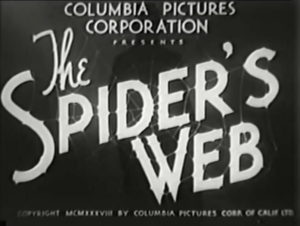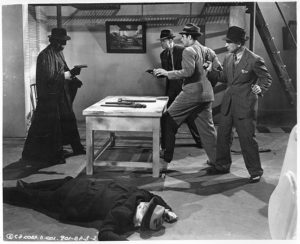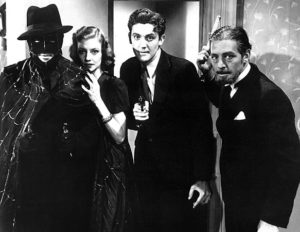 The Spider made his debut in the pulp magazines in 1933 in response to rival The Shadow. And it took only five years for it to make it to the screen in the form of a 15-part chapter play, The Spider’s Web, from Columbia Pictures. Months in advance, the magazines trumpeted its arrival on the big screen to the excitement of its faithful readers. And on Oct. 22, 1938, the first chapter “Night of Terror” hit theaters.
The Spider made his debut in the pulp magazines in 1933 in response to rival The Shadow. And it took only five years for it to make it to the screen in the form of a 15-part chapter play, The Spider’s Web, from Columbia Pictures. Months in advance, the magazines trumpeted its arrival on the big screen to the excitement of its faithful readers. And on Oct. 22, 1938, the first chapter “Night of Terror” hit theaters.
But this was more than a kids’ serial. The “action” (which today we’d call “violence”) of the usual Saturday morning serial was stepped up. And that was suitable for a pulp hero who was known for his high body count. You see, The Spider is a cloaked and masked hero who is a deadly crack shot. In chapter one, I lost count of the number of thugs who were felled by The Spider. Often in serials, a lot of gunfire is exchanged with no one getting hit. Not so in this chapter!
The premise of this serial plot has a hooded master criminal named “The Octopus” who wants to take over key industries and utilities. Transportation. Electrical power. Gas companies. So he sets out to bomb trains, blow up planes and generally throw the entire industry into chaos. But he’s messed with the wrong guy, when he takes on the wealthy Richard Wentworth. For, unknown to The Octopus, Wentworth is in reality The Spider, Master of Men!
[box]The Spider’s Web
Columbia Pictures, 1938, 15 chapters
Starring: Warren Hull, Iris Meredith
Directors: James W. Horne, Ray Taylor
[/box]The Spider (played by Warren Hull) is, of course, on the side of law and order. But he is assumed by Commissioner Kirk (played by Forbes Murray) and his Police Department to be a master criminal. (This seems to be a common problem encountered by crime fighters, such as The Green Hornet.) His actions are misinterpreted, and so he is forced to fight the police as well as The Octopus gang.
Who is Commissioner Kirk, you may ask? In the pulps, he was Commissioner Kirkpatrick, Wentworth’s best friend. But here, they have changed his name to Kirk. It’s not a nickname; that’s the way he’s billed in the credits and that’s what everyone calls him… including himself. Why they didn’t call him by his correct name is beyond me. But I guess it could have been worse. They could have changed Wentworth’s name to “Went” or something equally insulting.
And who is The Octopus? Ah, he’s the big baddie of the story. The super criminal… the master villain who plagues our hero right up until the climax in chapter 15. The Octopus is a mystery man dressed in white robes, cowl and mask. He walks with a crutch on his left side… his left leg being about a foot shorter. Why do I get the feeling that under that robe is a regular length left leg, just bent at the knee?
The Octopus gets his name, seemingly, from having more than two arms. About five minutes into chapter one, we see his robed figure sitting at a desk. He lifts the front of his robe with his left hand, and a third hand emerges holding a gun. It happens quickly, so you better not blink. But if you did, and you missed it, you’ll see the same footage repeated again in chapter seven. And he tries it again in chapter 15, but… hey, it’s the last chapter and you know what that means. The Octopus tries that “third arm” trick once too often when he meets up with The Spider. Fast on the draw, deadly accurate, The Spider beats The Octopus to the draw. Scratch one Octopus! But anyway, there lies the explanation for our master villain’s name. OK, so he doesn’t have eight arms. Let’s not get picky, here. Three is still pretty unusual, isn’t it?
Wait a minute. He never moves his right arm or right hand. In fact, the fingers on that right hand are always posed in the same frozen claw-like position. Am I the only one who finds that strange? Maybe it’ll be explained by chapter 15. Yeah, I bet it will. (No fair, guessing ahead.)
A blazing start
In chapter one, it’s established that Wentworth is about to marry Nita Van Sloane (played by Iris Meredith), and start out on their Hong Kong honeymoon. But The Octopus tries to crash their plane, and the whirlwind of thrills has begun! Nita and Richard survive by parachuting from the plane. Next, The Octopus sets out to bomb a vital bridge, one in which Nita just happens to be traveling across at the precise moment. Don’t we serial buffs just love those amazing coincidences?
Wentworth rescues Nita from the exploding bridge, and takes her to the hospital with a slight bump on the noggin. He then joins up with the gang in one of his many disguises, that of “Blinky” McQuade, a safecracker. (Yes, this was faithful to the pulp stories, where he often used the same disguise.) He learns that the bus terminal is about to be blown up, and races there to warn the innocent passengers. The Spider rushes into the bus station, has a gun battle with the hoodlums, and makes off with the bus that’s rigged to explode. And so it does, with him inside! Did our hero perish?
Obviously not, because just a few seconds later, the audience is shown some select scenes from the upcoming chapter two. And they see The Spider, and Wentworth and Blinky McCade continuing to battle The Octopus and his minions. The producers defeated the purpose of leaving the survival of The Spider in question until next week. The only question left is “how” he survived. I guess that was enough of a cliffhanger, because kids swarmed back into theaters the next Saturday morning, regular as clockwork!

Those “teasers” were one of the big weaknesses of this serial. Right after the cliffhanger, audiences are reassured that our hero didn’t really perish… because he is shown alive and kicking in clips from the next chapter. Columbia routinely did this with their serials, and I have always found it counterproductive. Maybe they didn’t want to traumatize the impressionable youngsters by leaving them in too much suspense for an entire week until the cliffhanger’s resolution the following Saturday morning. But that explanation doesn’t hold much water, considering all the other ways the serial could have traumatized the kiddies.
In chapter two, The Octopus tries to lure Wentworth into a trap, kidnapping Nita and using her as bait. The trap fails and Nita is rescued, only to fall with Wentworth from the top of an office building. Oh no, it’s certain death!
In chapter three, The Octopus changes his priorities: “Our main objective is to get The Spider.” But he still finds time to attempt to blow up a power plant. There’s a pitched gun battle and The Spider falls onto an electrical control panel! Millions of volts of electricity… a shower of sparks! It’s certain death for The Spider. Yeah, right…
Each chapter is much like another. Richard Wentworth discovers a plan by The Octopus to destroy something; a plant, a train, etc. He sets out to thwart the plan, and does so while setting himself up for the chapter cliffhanger… and certain death.
Making his mark
The mark of The Spider was a staple in the magazine stories. He placed it upon the foreheads of his criminal victims. It first appears in chapter three and again in chapter seven. Pretty cool, the spider image on the forehead of a gangster. Bet the kids in the theater ran home after the show and grabbed up their Spider pencils… the one with a spider carved into the eraser… and started rubber stamping their friends’ foreheads. I know I would have!
As with most serials that I watch, there were places where I just had to chuckle.
The Spider holds a gun on a thug and demands, “Do as you’re told and you won’t get hurt.” But then he doesn’t tell him to do anything. Jackson (Richard Fiske) ties the hoodlum up and that’s that. So what was the poor guy supposed to do in order not to get hurt? We’ll never know.
Next chapter… Oh no! Wentworth and Kirk step back in horror at… a small firecracker thrown on the floor. I guess the prop guy couldn’t find anything more menacing. And then it goes on to release clouds of poison gas. All from a tiny firecracker. Ah, the suspension of disbelief…
It did look pretty cool when the car went over the cliff and exploded into flames, but shouldn’t it have hit the ground before exploding? Instead, it had barely left the road before the explosion, and it was burning all the way down to the bottom of the ravine. No, there was no bomb aboard. Just a regular car… well, regular by serial standards, I guess.
Nita van Sloan, Ram Singh (Kenne Duncan) and Jackson are all different heights. Yet in chapter four when they are all three chained to a wall, and water is filling the room, the water reaches all their chins at the same time. Hmmm… I would have thought the shorter person would be the first to drown. Did our villain give Nita a stool to stand on? The diabolical fiend!
The resolution of the chapter 12 cliffhanger had me chuckling. The Spider is holding onto a couple wires, suspended between two apartment buildings high above the pavement. The bad guys chasing The Spider break loose the wires and The Spider falls! Okay, he doesn’t actually fall, as we see at the beginning of chapter thirteen. He holds onto the wires and swings down and — splat — hits the side of the neighboring apartment. This was a “Wile E. Coyote” moment if I ever saw one. In the cartoons, Wile E. Coyote would have been half flattened, his nose pushed upward. I nearly expected to see this. Maybe if it had been a Warner Bros. serial… but they didn’t make sound serials. Instead, after striking the building and still hanging on, The Spider just slid down the wires to the ground. I still think that just had to hurt, though.
I enjoyed an obvious ad-lib in chapter 15 when Wentworth, disguised as one-eyed Blinky McQuade, has trouble putting on his jacket. His arm won’t go through the sleeve. His comment to butler Jenkyns, “I can’t see very well.” And with that eyepatch on, I can certainly understand his dilemma. But they kept the camera running. No retakes unless absolutely necessary!
In addition to those parts that I found humorous, either intentionally or otherwise, there were other moments that were notable for other reasons.
In chapter five, Richard Wentworth plans to put on his magic act for a bus drivers’ benefit. Of course he only gets to walk onstage when gunfire breaks out from thugs in the audience. So we don’t get to see any of his magic act. But it does make me wonder if this was a nod to Warren Hull’s next serial for Columbia, Mandrake the Magician?
In chapter six, Jackson watches one of The Octopus’ henchmen dial a number, and later gives it to Wentworth. The number is DR 0-4414. Now think about that for a minute. How could you tell that the phone number started with DR by watching it being dialed? You would see the 3 and then the 7 being dialed, but that could mean DR or any of the other combinations of D through F (for the 3) and P through S (for the 7). It just as easily could have been FP 0-4414. Or… well, you get the idea. Just another one of those gaps in logic that kids watching the serial weren’t supposed to notice. And with all the action taking place on-screen, they probably didn’t.
In chapter seven, The Spider uses one of his oft-used ploys from the pulp stories. When The Spider is trapped by the police, he removes his Spider garb and runs up to an officer: “The Spider’s upstairs. He’s after me!” And the police let him through, while they run upstairs on a futile search. It’s good to see that the scriptwriters read some of the pulp stories before sitting down to their movie serial script.
In chapter eight, Wentworth meets with a group of industrialists. He believes that one of them is The Octopus, and a ruse proves his theory. Which one of the businessmen under suspicion of being The Octopus is the guilty party? I doubt if kids back in 1939 could tell them apart… I certainly couldn’t. But it’s good for a few chapters to track down a couple false trails and cast some suspicion on various parties. When the unmasking happens in chapter 15, no one seems to really care. Including the audience, I’m sure.
In the pulps, Nita was no damsel in distress, but was a capable fighter in her own right. That was translated accurately into the serial, as notably evidenced in chapter eight when Nita trails The Octopus gang while riding on the rear bumper of their fleeing automobile. Now that’s grit.
A shoestring budget
A ray gun! What self-respecting serial wouldn’t have one! And The Spider’s Web is no exception. In chapter nine, there’s a big old ray gun. The Octopus refers to it as “my super ray run.” No small handheld models here, so sirree. This is a huge console model ray gun. But it isn’t until the next chapter that we get to see the deadly ray gun in action. It glows, it flashes and it shoots aircraft out of the skies… but then isn’t that what they usually do? And do we see the makings of a chapter cliffhanger, here? Yes, Richard Wentworth finds an excuse to fly somewhere, and just happens to fly over the same terrain where the ray run is hidden in a travel trailer. Bzzzzaap! And just like a mosquito flying into an electric bug zapper, Wentworth’s plan meets a fiery doom and Wentworth faces “certain death.”
I gotta say, though, that some of the special effects were just downright embarrassing. Like the aircraft hit by the super ray gun that falls to earth in flames. It sure looks like someone just set a wooden model of an airplane afire and dropped it. There wasn’t even any attempt to give it forward momentum. It just falls straight down.
Serials were made on a shoestring budget, and often reused footage from other films. This one was no exception. That death ray footage was recycled from Air Hawks, a B-feature that Columbia put out in 1935.

In chapter 12, Wentworth is accused of being The Spider. That happens in the pulps a lot, too. This time, Wentworth calls Jackson, and right in front of the Commissioner and other police, he sends Jackson a secret message via surreptitiously tapping on the telephone receiver while he talks. Morse code. (In the serials, everybody knew Morse code.) So Jackson dresses up as The Spider and appears before the assemblage, proving that Wentworth is innocent. This was also taken from the pulps… appearing more than once, actually.
In the pulps, The Spider is a deadly shot with perfect aim. And that’s how this serial starts out, too. In chapter one he shoots… he scores! Then as the chapters wear on, he seems to loose that ability. Nearly every chapter has a gun battle, but our hero starts missing more and more. By the chapter 14 shootout at the bus station, there’s a prolonged fury of gunfire, but The Spider misses every time. Finally the police arrive and The Spider escapes, leaving the thugs in police custody but unscathed. Not a single thug had been hit by The Spider. What happened? He redeems himself in chapter 15 when he finally meets up with The Octopus, he suddenly regains his accuracy. Five gunshots and five henchmen drop. Atta boy, Spider!
Chapter 14 is pretty good, because it’s setting up the final cliffhanger and the ultimate resolution of the storyline. Jackson is kidnapped; Jenkyns is attacked; henchmen are captured; the poison-gas firecrackers make a return; Nita is in peril; men ride on running boards. Three suspects remain who might be The Octopus. And The Spider falls through a trap door to “certain death.”
And then finally we reach chapter 15, where The Spider invades the hideout of The Octopus and defeats him. The Spider puts his mark on The Octopus’s forehead for the police to find. I’ve got to admit, though, that it looks more like the Batman’s symbol than a spider. But let’s not get picky, here. The “real” Batman symbol showed up five years later in Columbia’s Batman serial. And just like The Spider, Batman stamps his symbol on the forehead of the crooks he captures, leaving them for the police to pick up. Just remember, though, it all started with The Spider.
Finally, it’s all over. With The Octopus out of the way (which one of the remaining three suspects was he, anyway? I couldn’t tell) now Nita and Richard Wentworth are free to marry and start on their honeymoon. But somehow, I get the feeling some new villain will arise to threatened the populace before the wedding bells can be rung. That’s the fate preordained for The Spider.
The verdict
My final evaluation… This was probably one of the top 20 serials of all time. Yes there were times that I laughed at some absurdity. But serial aficionados know that you can’t take these things too seriously. There’s that “suspension of disbelief” thing. There was plenty of action and the serial kept faith with the pulp readers, being a closer adaptation than just about any other derived serial out there.
I can only imagine how many kids tied the ends of a blanket around their necks them to create a cape so they could play “The Spider.” Hey, if I had been a kid back then, I know I would have! That’s pulp!


Great review. It looks like your blog is going to be as high quality as your legendary Shadow reviews. Keep up the good work.
Thanks for the kind words, Larry. I’m looking forward to doing lots of things on this new blog that I constrained from doing on my old web site. There, I was obligated to keep to things related to The Shadow. Now, I can open up the subjects to all sorts of things that I find interesting.
A big thank you must go to Bill Lampkin for opening up this wonderful new playground for me. Hope you’ll check back next week, and see what new thing has caught my eye.
Glad to have you blogging, John!
What a debut! This thrilling and hilarious, yet clearly affectionate appreciation was the next best thing to seeing the serial. (Or maybe better?)
Hi Mike! This was such a fun serial that the review practically wrote itself. That’s how you know something was good… it’s not work at all to write about it. If you ever get a chance to watch this wonderful old chapter-play, don’t pass it by. It’s truly enjoyable for everyone, but especially if you’ve read some of the pulp adventures of The Spider.
One of my favorite serials. I’ve seen it a couple times on video tape and a couple years ago Pulpfest ran it for three nights, at 5 chapters a night. My favorite scene was when the Spider guns down a little old lady. Shoots her in the back as she is running away but of course it must have been a crook dressed up but it didn’t fool The Spider!
I had forgotten about that scene. But it is so wonderfully Spiderish! That was one mean crimefighter. Designed to compete against The Shadow, and succeeded quite well, if you ask me.
At Pulpfest, did they show it on a big screen? I watched it on an 80 inch TV screen, but it really cries to be shown on something bigger. That’s the way I wish I could see it.
Yes, it was on the big screen and despite the lateness of the night, I had to stay up and watch the 5 chapters each night.
The upcoming issue of BLOOD ‘N’ THUNDER (Fall 2015) will have a revised and expanded version of the SPIDER’S WEB article I wrote last year for one of Sanctum Books’ Spider reprint volumes. Lots of behind-the-scenes info on the making of the serial, including quotes from my 1975 interview with Iris Meredith, who played Nita.
Excellent news, Ed! I love behind-the-scenes stuff. Your upcoming article will be eagerly anticipated by us all.